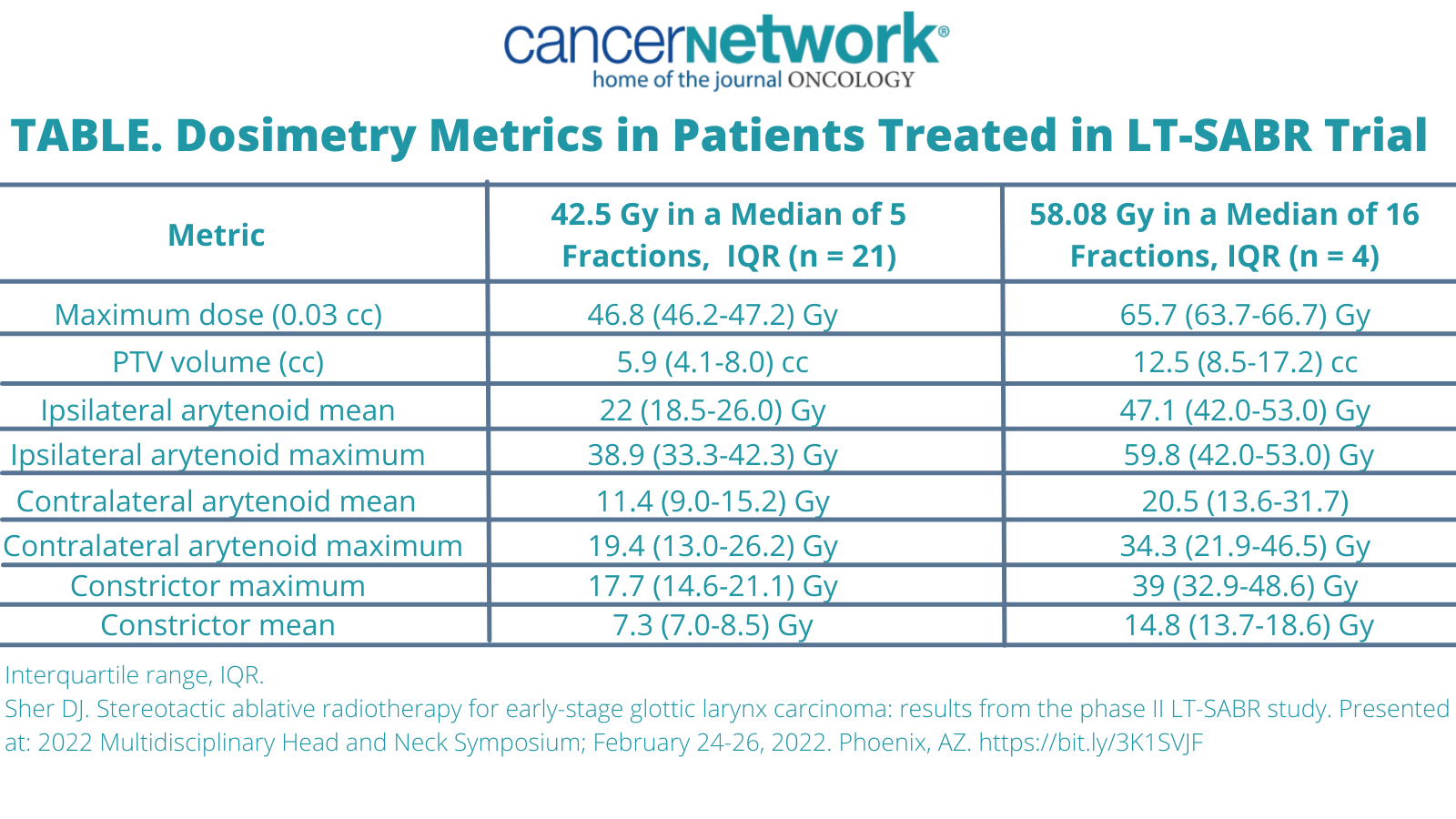Tumor-Focused Stereotactic Radiotherapy May be Efficacious in Early Stage Glottic Larynx Carcinoma
Patients with early stage glottic larynx carcinoma benefitted from treatment with tumor-focused stereotactic radiotherapy.
Treatment with tumor-focused stereotactic radiotherapy resulted in promising efficacy and patient reported outcomes (PROs) in those with early stage glottic larynx carcinoma, according to findings from the phase 2 LT-SABR study (NCT03548285) presented at the 2022 Multidisciplinary Head and Neck Cancers Symposium.
After a median follow up of 23.3 months (IQR, 17.1-31.1), investigators reported 2 cases of local recurrence with 1- and 2-year cumulative incidence of local recurrence of 4% and 8.8%, respectively. Another patient experienced in-field recurrence 13 months following completion of radiotherapy at 5 fractions and was salvaged with vertical partial hemilaryngectomy; the patient had no evidence of disease at 14 months. Another patient, who was treated with 16 fractions of radiotherapy, had persistent disease including synchronous regional and distant metastases 4 months following completion of treatment.
“…Both this LT-SABR phase 2 and the phase 1 CK study have shown that stereotactic-level treatments—though done very carefully—are feasible and efficacious,” David Sher, MD, chief of head and neck radiation oncology service at Harold C. Simmons Comprehensive Cancer Center, explained. “More work needs to be done but I am hopeful it can become another tool in the toolbox to successfully treat these cancers while maximizing quality of life.”
Eligibility criteria required that patients have pathologically proven squamous cell carcinoma including in situ, and any variant. Patients were required to have stage 0 to II disease with no extension beyond the vocal process of the arytenoid. Exclusion criteria included previous curative intent surgical treatment and smoking more than 1 pack per day.
The study's primary end point was 2-year risk of local failure anywhere in the larynx. Secondary end points included PROs, grade 3 or higher toxicity, and cumulative risk of marginal or out of field failure, regional recurrence, and distant metastases.
For patients with a planning target volume (PTV) of 10 cc or less who weren't active smokers, 42.5 Gy was administered in 5 fractions twice per week. Active smokers with a PTV of more than 10 cc received 58.08 Gy in 16 daily fractions. The typical beam arrangement included 2 coplanar arcs and 2 non-coplanar arcs at 40 degrees. Therapy was delivered via VisionRT-based swallow gating.
TABLE. Dosimetry Metrics in Patients Treated in LT-SABR Trial

A total of 25 patients were enrolled on the study from July 2018 to April 2021.
Patients had a median age of 72 years and almost all patients were men (96%). The most common disease stages were T1a (64%) and T1b (20%). In total, 74% of patients previously smoked.
In terms of PROs, patients had a voice handicap index of 49.5 at baseline, 9.8 at 6 months, and 15.9 at 12 months (P <.001). Additionally, patients had an EORTC swallowing subscale score of 1.4 at baseline, 3.6 at 1 month, and 2.5 at 12 months.
Investigators did not observe any acute or late grade 3 toxicities.
Reference
Sher DJ. Stereotactic ablative radiotherapy for early-stage glottic larynx carcinoma: results from the phase II LT-SABR study. Presented at: 2022 Multidisciplinary Head and Neck Symposium; February 24-26, 2022. Phoenix, AZ. https://bit.ly/3K1SVJF